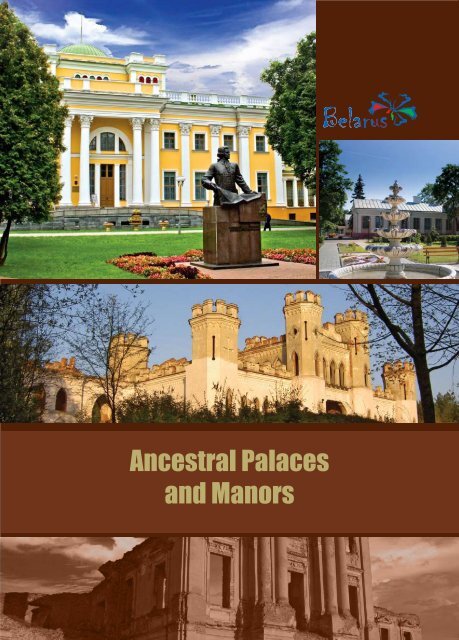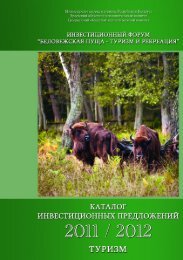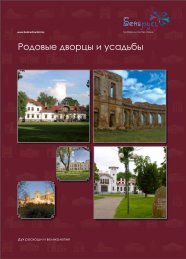Create successful ePaper yourself
Turn your PDF publications into a flip-book with our unique Google optimized e-Paper software.
<strong>Ancestral</strong> <strong>Palaces</strong><br />
<strong>and</strong> <strong>Manors</strong>
<strong>Ancestral</strong><br />
P a l a c e s<br />
& <strong>Manors</strong><br />
9<br />
2<br />
Map of Objects<br />
6<br />
3<br />
4<br />
15<br />
12<br />
14<br />
Minsk<br />
10<br />
5<br />
8<br />
7<br />
11<br />
page<br />
1. The Palace of the Rumyantsevs-Paskevichs’ 2<br />
2. The Sapegas’ Palatial Complex 4<br />
3. The Palace of the Puslovskys 6<br />
4. The Butrimovich Palace 8<br />
5. The Bulgaks’ Palace 10<br />
6. The Umestovskys’ Palace 12<br />
7. The Gatovskys’ Manor 13<br />
8. The Governor’s Palace 14<br />
9. The Palace of the Valovichs’ 16<br />
10. The Priluky Manor 18<br />
11. The Bishop’s Palace 20<br />
12. The Rdultovskys’ Palace 22<br />
13. The Potyomkin Palace 24<br />
14. The Tizenhaus Palace 26<br />
15. The Palace of the Tyshkevichs’ 28<br />
1<br />
13
<strong>Ancestral</strong> <strong>Palaces</strong> <strong>and</strong> <strong>Manors</strong><br />
he Sapegas, Rumyantsevs, Paskevichs,<br />
Chapskis, Tisenhauses… Their luxurious<br />
palaces, gorgeous family castles <strong>and</strong><br />
manors erected by eminent architects were<br />
imbued with special aura where intelligent,<br />
educated, <strong>and</strong> progressive personalities<br />
used to meet. The owners were proud of huge libraries collected<br />
with special care <strong>and</strong> love, art collections <strong>and</strong> greenhouses full<br />
of rare for our latitude plants. For example, Earl Puslovsky had<br />
an in-house menagerie, the Sapegas could boast of the own<br />
theatre <strong>and</strong> the largest library in the Gr<strong>and</strong> Duchy of Lithuania,<br />
Tizengaus founded an ornithological museum…<br />
People’s rumor gave rise to different legends about treasures,<br />
ghosts <strong>and</strong> underground labyrinths, the mysteries thereof are<br />
safely kept by ancient walls.<br />
We cordially invite you to visit the original architecture of ‘family<br />
nests’, w<strong>and</strong>er around the paths <strong>and</strong> lanes, be inspired with the<br />
light of History <strong>and</strong> get everlasting impressions of an encounter<br />
with our blue-eyed Belarus.<br />
The National Tourism Agency<br />
of the Republic of Belarus
<strong>Ancestral</strong><br />
P a l a c e s<br />
& <strong>Manors</strong><br />
Gomel,<br />
Gomel region<br />
2<br />
The Palace of the<br />
Rumyantsevs-<br />
Paskevichs’<br />
The Rumyantsevs-Paskevichs’<br />
Palace is located on the<br />
steep bank of the river Sozh<br />
surrounded by a gorgeous park<br />
<strong>and</strong> romantic l<strong>and</strong>scape. Its first<br />
owner <strong>and</strong> erector was Field Marshal<br />
Petr Alex<strong>and</strong>rovich Rumyantsev-Zadunaisky,<br />
who received the ‘Gomel village’ as a present<br />
from Ekaterina II for his military merits. The unique natural <strong>and</strong><br />
architectural ensemble was created owing to endeavours of the<br />
manor proprietors, the Rumyantsevs <strong>and</strong> Patskevichs, the families<br />
of famous in the Russian Empire military <strong>and</strong> state figures.<br />
At present it is one of the most popular attractions for tourists.<br />
It consists of a Palace, St. Peter <strong>and</strong> Paul’s Cathedral, close to<br />
which there is a chapel <strong>and</strong> family burial vault of the Paskevichs.<br />
The chapel was the first monument restored in the republic after<br />
the war.<br />
The exposition of the complex has over 150 thous<strong>and</strong> of exhibits,<br />
among which there are genuine rarities. Unfortunately, many<br />
valuables vanished. Yet, lucky findings sometimes happen.<br />
For example, the bronze goddess Mir, who used to guard the<br />
Chancellor’s peace <strong>and</strong> quiet, was returned from Voronezh. It is one<br />
of the three copies of the marble sculpture made by Italian Antonio<br />
Kanove. The Gomel goddess was reproduced in metal (35 poods<br />
of bronze) by master Deput-Malinovsky from Saint-Petersburg. Only<br />
in our times the Palace acquired a real treasure, the copy of the<br />
Gospel by Peter Mstislavets, which dates back to 1575.
The palatine park is a magnificent sample of woodl<strong>and</strong> art of<br />
the late 18th <strong>and</strong> early 19th centuries. The l<strong>and</strong>scape design was<br />
made by Polish architect Adam Idzkovsky. He was the author<br />
of a painting depicting the Palace (its image is reproduced<br />
on the Belarusian banknote of 20 thous<strong>and</strong> value), which<br />
reconstruction <strong>and</strong> completion he was in charge of.
<strong>Ancestral</strong><br />
P a l a c e s<br />
& <strong>Manors</strong><br />
Ruzhany,<br />
Pruzhany district,<br />
Brest region<br />
4<br />
The Sapegas’<br />
Palatial Complex<br />
The palatial complex in<br />
Ruzhany erected in the<br />
early 17th century is called<br />
Belarusian Versailles. It was a family<br />
residence of the mighty Sapegas. The<br />
most significant contribution to history was<br />
made by Lev Sapega. He was educated in the<br />
Leipzig University. At the age of 33 he was appointed<br />
to the post of Chancellor of the Gr<strong>and</strong> Duchy of Lithuania. Lev<br />
Sapega headed the working commission on development of the<br />
Statute of the Gr<strong>and</strong> Duchy of Lithuania in 1588, which in fact was<br />
the state constitution <strong>and</strong> remained in force till 1840 in Belarus.<br />
Originally an unapproachable fortress was built in Ruzhany in 1617.<br />
Military arsenal, food supplies, <strong>and</strong> important documents were kept<br />
in its four-storied subterrenes. According to one of the versions, the<br />
underpass connected the Palace with the church in Synkovichi <strong>and</strong><br />
the castle in Kossovo.<br />
During the Northern war (1700-1721) the stone Palace was almost<br />
destroyed. The estate’s second birth fell to 1784-1788. Under the<br />
instruction of Alex<strong>and</strong>er Sapega, architect Yan Samuel Bekker could<br />
create a real wonder. Semicircular arcades stretching from the<br />
wings of the main building linked it with side buildings <strong>and</strong> an entry<br />
frame with two-sides adjoining annexes. The Ruzhanski Palace was<br />
famous for its theatre, which was equipped perfectly well for those<br />
times <strong>and</strong> had an ample art gallery. The largest library of the Gr<strong>and</strong><br />
Duchy of Lithuania gave grounds for a special pride of its owners.
…Today the survived parts of the Palace, arcade, entry frame with<br />
an oak cartouche <strong>and</strong> a garl<strong>and</strong> remind the bygone splendor.<br />
And the alluring myth about the buried gold treasure of the mighty<br />
magnates continues to heat the imagination of adventurers…
<strong>Ancestral</strong><br />
P a l a c e s<br />
& <strong>Manors</strong><br />
Kossovo,<br />
Ivatsevichi district,<br />
Brest region<br />
6<br />
The Palace of the<br />
Puslovskys<br />
A<br />
rich manufacturer Earl<br />
V<strong>and</strong>alin Puslovsky built his<br />
country seat in the natural<br />
l<strong>and</strong>mark Merechevshchina lying 1.5 km<br />
remote from Kossovo. A huge Neo-Gothic<br />
construction with toothed parapet round the<br />
building perimeter, faceted towers at corners, wall<br />
loopholes, narrow lancet arches-shaped door <strong>and</strong> window<br />
apertures is a real medieval fortress. Twelve castle towers symbolized the<br />
months of the year. It was built in the way that the sun could light every room<br />
for two <strong>and</strong> a half days all the year round, <strong>and</strong> the system of inner passages<br />
<strong>and</strong> windows made it possible for the sunbeams to penetrate into every<br />
Palace corner. The story says every room was decorated on its ‘room day’<br />
<strong>and</strong> became the place of celebration of a sunny day.<br />
Contemporaries said the residence consisted of 132 halls <strong>and</strong> none of them<br />
resembled the other. Every room had its own name <strong>and</strong> function. One of the<br />
rooms with black marble walls had a glass floor through which visitors could<br />
see bright fish swimming. The Black Hall was intended for playing cards. Balls<br />
were held in the White Hall with refined décor. The rooms were decorated<br />
with tapestry <strong>and</strong> expensive carpets hanging on the walls. All halls were<br />
heated by mantelpieces finished with carved marble <strong>and</strong> sculptures.<br />
The menagerie was located on the castle ground floor, <strong>and</strong> the story says<br />
that a lion was let out of the cage at night. The king of beasts was roaming
along the corridors guarding its residents. They say that to hear the<br />
‘voice’ of the castle, one should simply knock on the wall left to the<br />
main entrance at the height of approximately two meters.<br />
As well as many other historic monuments of Belarus, the ‘biography’<br />
of the castle of Puslovski abounds in sorrowful events: it changed its<br />
owners, was deprived of the valuables, suffered from the elements,<br />
wars <strong>and</strong> fires. Yet the Palace greatness is still exciting people’s<br />
imagination…
<strong>Ancestral</strong><br />
P a l a c e s<br />
& <strong>Manors</strong><br />
Pinsk,<br />
Brest region<br />
8<br />
The Butrimovich<br />
Palace<br />
The Palace was built to<br />
the order of a prosperous<br />
financier Mateush<br />
Butrimovich. The first stone in the<br />
foundation of the future construction<br />
was laid by King of Rzech Pospolita<br />
Stanislaw August Ponyatovsky. The building<br />
is unique due to its architecture of a transitional<br />
type from Baroque to Classicism with improvisation of canonical<br />
forms in individual parts <strong>and</strong> details. Baroque was adhered to in<br />
construction of the plan with concave curvilinear lines of angular<br />
parts, an oval-shaped main hall, facade traditional partitioning<br />
into two circles decoratively contrasted.<br />
The building is symmetric. Its three parts form the gr<strong>and</strong> court<br />
facing the river Pina. The middle building consists of show rooms,<br />
side buildings house living rooms <strong>and</strong> offices. The projecting oval<br />
hall which leads to the terrace is in the centre of the Palace. This<br />
part of the facade resembling an original bay window is the most<br />
decorated.<br />
The Palace magnificent interior was ruined in the result of a big<br />
fire in 1901. Many valuables were lost: paintings of Dutch masters,<br />
ancient Venetian ch<strong>and</strong>eliers, oriental carpets, gobelins <strong>and</strong> the<br />
collection of Slutsk belts. Experts assume many works by Napoleon<br />
Orda were taken away during the First World War.
<strong>Ancestral</strong><br />
P a l a c e s<br />
& <strong>Manors</strong><br />
Zhilichi,<br />
Kirovsk district,<br />
Mogilyov region<br />
10<br />
The Bulgaks’<br />
Palace<br />
The Palace amazes people<br />
by its proportions. L<strong>and</strong>lord<br />
<strong>and</strong> prosperous businessman<br />
Ignatiy Bulgak intended to erect the<br />
most beautiful residence in Belarus, so<br />
he opted not to economize on the Palace<br />
construction project.<br />
The ensemble created by K.Podchashinskis, a well-known Lithuanian<br />
architect, was in line with classical traditions of the early 19th<br />
century. The Palace is a complex of multi-storied buildings. Its main<br />
two-storied building has two adjoining short side-wings. There is a<br />
church built in into one of the wings of the Palace, <strong>and</strong> a tropical<br />
greenhouse in the other wing. The part of the Palace adjoining<br />
wings st<strong>and</strong>s out with its facade arrangement <strong>and</strong> window apertures<br />
shape.<br />
The front door leads to a spacious lobby ceiled with a cross-vaulting.<br />
The doors open into the rooms on the ground floor, the staircase<br />
leads to the first floor where gr<strong>and</strong> apartments are located. The<br />
interior of the rooms <strong>and</strong> halls sports numerous decorations, including<br />
mahogany <strong>and</strong> mouldings.<br />
Ignatiy Bulgak, the owner of the Palace, had a taste for music,<br />
<strong>and</strong> for this reason all rooms <strong>and</strong> halls of the Palace have good<br />
acoustics. There used to be a secret level in the Palace for the<br />
musicians to quietly sneak to the balconies <strong>and</strong> play music for the<br />
audience. Unfortunately, the luxurious residence owner died soon<br />
after the construction of the Palace was finished. His son Edgar<br />
inherited the Palace.
Unlike many other architectural monuments on the l<strong>and</strong> of Belarus,<br />
the Bulgak Palace has been lucky to remain intact all through the<br />
wars of the 20th century. Not a single bomb would fall on or near the<br />
building, <strong>and</strong> the wartime fires passed it by.
<strong>Ancestral</strong><br />
P a l a c e s<br />
& <strong>Manors</strong><br />
Zhemyslavl,<br />
Ivie district,<br />
Grodno region<br />
12<br />
The Umestovskys’<br />
Palace<br />
The manor of Earls Umestovsky<br />
is the copy of the royal<br />
residence of Rzech Pospolita<br />
belonging to King Stanislaw August<br />
“Lazenka”.<br />
A classical two-storied building with a<br />
promenade ground on the flat roof naturally suited the<br />
surrounding l<strong>and</strong>scape. The belvedere arched windows covered<br />
the coloured stained-glass windows. Over the front door on the four<br />
columns of the Corinthian order there was an open loggia with a<br />
mosaic floor. The first floor was ornamented with laced balconies,<br />
the ends of the building were connected with lower annexes with<br />
open terraces. The inner layout <strong>and</strong> interior was also ‘Warsaw' styled<br />
including marble mantelpieces, ingenious parquet pattern, murals.<br />
The residence was surrounded with an English park having an<br />
artificial pond <strong>and</strong> boat mooring. The over-the-river side of the park<br />
accommodated a high octal “skarbets” with an arcade gallery on<br />
the perimeter. Separate premises were occupied by warehouses,<br />
a stable, a family chapel, a winehouse <strong>and</strong> a cheese dairy.<br />
The last owner Wladyslaw Umestovsky submitted the manor for<br />
scientific research of Vilnya University devoted to nature <strong>and</strong><br />
agriculture study. All major manor constructions remained almost<br />
intact with time, yet the interior preserved only some fragments of<br />
ceiling molding <strong>and</strong> floor tiled mosaic.
The Gatovskys’<br />
Manor<br />
The palace <strong>and</strong> park complex<br />
was erected according to<br />
the order of engineering<br />
Lieutenant General Mikhail Gatovsky<br />
in the second half of the 19th century<br />
<strong>and</strong> remained almost intact to our times.<br />
The complex consists of a Palace, a wing, household<br />
constructions <strong>and</strong> a splendid park with birch <strong>and</strong> lime lanes.<br />
A channel in the park leads to the river with three bridges across it.<br />
The Palace was built in 1890-1893 combining two architectural<br />
styles – Neo-Gothic <strong>and</strong> Neo-Renaissance. The tower marquees,<br />
bay windows, attic roofs, <strong>and</strong> dormer windows imbue the building<br />
with special fascination. An original combination of red-brick <strong>and</strong><br />
plastered white walls makes the Palace exterior very impressive.<br />
The Palace inner layout is a suite of rooms finished in different styles:<br />
Roman, Arabian, Renaissance, French of the times of Louis XVI. The<br />
luxurious interior abounds in mouldings, refined carving <strong>and</strong> friezes,<br />
wall decorations. Every interior detail was well thought-over including<br />
lamps, bronze statuettes, Venetian cut glass, English faience, French<br />
porcelain.<br />
The art collection belonging to the Manor owners included the<br />
masterpieces by Aivazovsky, Semiradsky, <strong>and</strong> other talented artists<br />
(mainly of the 19th century).<br />
13<br />
<strong>Ancestral</strong><br />
P a l a c e s<br />
& <strong>Manors</strong><br />
Krasny Bereg,<br />
Zlobin district,<br />
Gomel region
<strong>Ancestral</strong><br />
P a l a c e s<br />
& <strong>Manors</strong><br />
Vitebsk,<br />
Vitebsk region<br />
14<br />
The Governor’s<br />
Palace<br />
The Palace is one of the sights<br />
of the ancient Vitebsk, which<br />
silently witnessed the last 150<br />
years of the town history.<br />
It was the residence of all governors<br />
of the Vitebsk province. The Russian writer<br />
I. Lazhechnikov held the post of Vice-governor for<br />
sometime (1853-1854).<br />
The appearance of the building built in the late 18th century on<br />
the high bank of Western Dvina was influenced by Russian classical<br />
architecture. The main building has three storeys with its middle<br />
projecting part treated by an order. The building facing the river<br />
is two-storied: the ground floor is rusticated, the windows are<br />
rectangular, the first floor is adorned with archways.<br />
Once Napoleon chose the governor’s residence as the place of his<br />
stay. The Palace evidenced the celebration of the 43d birthday of<br />
the French Emperor on August, 3 (August, 15 according to the New<br />
Style), 1812.
During the October Revolution the Military <strong>and</strong> Revolutionary<br />
Committee which proclaimed Soviet power in the town <strong>and</strong><br />
province held its meetings in the Palace. It hosted the first Vitebsk<br />
provincial conference of the Russian Social-democratic Workers’<br />
Party. M.I. Kalinin made a speech at the extended session of Vitebsk<br />
provincial executive committee in June, 1919.
<strong>Ancestral</strong><br />
P a l a c e s<br />
& <strong>Manors</strong><br />
Svyatsk,<br />
Grodno district,<br />
Grodno region<br />
16<br />
The Palace of<br />
the Valovichs’<br />
The Palace for the magnates<br />
Valovichs was constructed<br />
in the Baroque style with<br />
elements of Classicism by Italian<br />
architect Juseppe Sacco in 1779.<br />
The complex consists of three buildings: one<br />
central part <strong>and</strong> two wings. The main building is linked<br />
with two lateral wings by semicircular galleries. A central staircase,<br />
halls, the drawing room, <strong>and</strong> other rooms are located in the<br />
main building. It uses a widely-spread in those times composition<br />
method of the facade with three projections. Each of the slightly<br />
bulging lateral projections is spotted with coupled pilasters. Lateral<br />
projections are crowned with bent pediments.<br />
In the park façade, lateral projections are contrasted with the<br />
pentahedral ledge of the main halls decorated with pilasters <strong>and</strong><br />
capped by a figured roof. The building interior finishing lasted till the<br />
end of the 18th century. Two types of decoration - moulded <strong>and</strong><br />
painterly - were applied in the interior design.<br />
According to the Svyatsk legend, the daughter of the l<strong>and</strong>owner<br />
Valovich fell in love with a groom. The enraged father ordered to<br />
drown the guy in the pond, <strong>and</strong> to immure his daughter alive into<br />
the Palace wall. They say that since then the ghost of the girl has<br />
been w<strong>and</strong>ering around the house every night…<br />
The Palace of the Valovichs is located in vicinities of Augustovsky<br />
Canal <strong>and</strong> can become a real attraction for tourists.
<strong>Ancestral</strong><br />
P a l a c e s<br />
& <strong>Manors</strong><br />
Priluki,<br />
Minsk district,<br />
Minsk region<br />
18<br />
The Priluky<br />
Manor<br />
The Priluky Manor with its<br />
refined Gothic features<br />
was deservedly considered<br />
one of the most attractive in the<br />
Minsk region. It became the Chapsky<br />
residence in 1872 <strong>and</strong> remained their<br />
property till 1917.<br />
The magnificent Neo-Gothic Palace had a number of towers <strong>and</strong><br />
turrets, fortified teeth <strong>and</strong> facades in the spirit of Romanticism.<br />
The Palace interior looked rather ‘modest’. Documents showed<br />
that along with nice parquet <strong>and</strong> gilt ceiling moulding in the<br />
show rooms, there was an oak <strong>and</strong> leather garniture, grotto<br />
work furniture in the style of Louis ХV, two gr<strong>and</strong> pianos, a piano,<br />
beautiful wardrobes, Gdansk chests, paintings by Yan Mateyko,<br />
family portraits, miniatures of the 18-19th centuries, silver, Saxon<br />
<strong>and</strong> French porcelain…<br />
…In our times as well, an eight-metres-wide avenue leads to the<br />
Palace from the entrance (“brama”), which is shaped as faceted<br />
pylons with spheres above. Its length equals to 365 steps - the<br />
number of days in the year.
One of the versions states that the residence was<br />
reconstructed from an old monastery. Soon after that rumour<br />
spread about a ghost inhabiting the Palace...<br />
Now the Palace houses the Belarus Scientific Research<br />
Institute of Plants Protection.
<strong>Ancestral</strong><br />
P a l a c e s<br />
& <strong>Manors</strong><br />
Mogilyov,<br />
Mogilyov region<br />
20<br />
The Bishop’s<br />
Palace<br />
The Bishop’s Palace<br />
of George Konissky,<br />
a prominent Orthodox<br />
personality, was built according to<br />
the project of Vilnius architect Yan<br />
Glaubitsa.<br />
The Palace exterior has typical characteristics of<br />
Baroque: plastic art in the facades, niches, <strong>and</strong> intricate platb<strong>and</strong>s.<br />
The high unusually-shaped roof of the building suits the style of the<br />
facades.<br />
The lay-out of the complex was originally conceived to be<br />
symmetrical: there was a palace in the town centre, to the right<br />
<strong>and</strong> left there were monastic cells forming a gr<strong>and</strong> court. The cells<br />
were connected to the main entrance gates by a laced metal<br />
fencing.<br />
The Palace building represents a compact rectangle with ledgesprojections<br />
in angular parts. Internal rooms were spacious. The<br />
lobby <strong>and</strong> the reception hall were located in the centre of<br />
the ground floor. The owner’s personal rooms, a study <strong>and</strong> a<br />
library were on the first floor. In the middle of the Palace there<br />
is a second attic floor with small rooms which, probably, were<br />
intended for service staff <strong>and</strong> visitors.
Up to now the building has partly survived. Today the Bishop’s<br />
Palace is a historic <strong>and</strong> architectural monument of one of the<br />
ancient towns of Belarus.
<strong>Ancestral</strong><br />
P a l a c e s<br />
& <strong>Manors</strong><br />
Snov,<br />
Nesvizh district,<br />
Minsk region<br />
22<br />
The Rdultovskys’<br />
Palace<br />
The Palace located on<br />
the bank of the river<br />
Snovenka was built by<br />
Kazimir Rdultovsky, a Belarusian<br />
nobleman, Oxford graduate, Doctor<br />
of Philosophy, in 1827. The Palace amazes<br />
people by its proportions: it is 140 meters long,<br />
originally it had 100 rooms <strong>and</strong> a stateroom.<br />
The Palace architecture is laconic. Proportionality <strong>and</strong> grace of<br />
porticoes with beautifully drawn capitals, laced projections with<br />
wide two-floors three-part windows, modest decorative panels<br />
at the arch end of the windows made the exterior graceful <strong>and</strong><br />
magnificent.<br />
The central part of the Palace <strong>and</strong> flanking projections are<br />
located on two floors. Lateral wings are one-storied: the left<br />
wing is an open gallery, a colonnade, <strong>and</strong> the right wing is a<br />
colonnade adjoining the front wall. The structure of flanking parts<br />
is very simple: windows with canopies are located in shallow <strong>and</strong><br />
flat niches, <strong>and</strong> a floret relief is placed in the top part of the wall.<br />
The state hall with the total area of 100 sq. m has a plain interior.<br />
Ceilings <strong>and</strong> walls are not decorated. Only the top part of the<br />
hall walls has the eaves. Along with an alcove, a big well-made<br />
glased tile stove serve as decorations.
The Rdultovskys’ Palace ranks among the best monuments of the<br />
epoch of Classicism.
<strong>Ancestral</strong><br />
P a l a c e s<br />
& <strong>Manors</strong><br />
Krichev,<br />
Mogilyov region<br />
24<br />
The Potyomkin<br />
Palace<br />
The Potyomkin Palace is a<br />
monument of architecture<br />
of early Classicism. It was<br />
constructed under the project of<br />
architect Starova (the author of the<br />
Taurian Palace in Saint-Petersburg) in<br />
1778-1787. It represents a two-storied stone<br />
building with a suite of rooms. In the middle of each<br />
floor there are round halls projecting beyond the limits of the Palace<br />
towards the court yard.<br />
Architectural <strong>and</strong> art exterior decoration belongs to the pseudo-<br />
Gothic style. The main facade is adorned with toothed faceted<br />
pylons, window apertures are ogival. Yet the Palace facades facing<br />
the park are of the classical style.<br />
Grigory Potyomkin was an outst<strong>and</strong>ing person. The Krichevsky<br />
Palace is a live proof to it. The unique building totals the area<br />
of 1120 sq. m, every 90-centimenters thick stone wall is bearing.<br />
The interior of more than 40 halls was adorned with mouldings,<br />
fireplaces <strong>and</strong> stoves were finished with original tile. The<br />
l<strong>and</strong>scape park adjoins the Palace porch, some old lindens have<br />
remained in the orchard to these days.
At the height of the bird's flight one can see that the Palace is<br />
Е-shaped. It was the way for the favourite of the Empress to show<br />
his fidelity to Ekaterina. The sovereign visited the Palace on January,<br />
19th, 1787 during her regular trip to new provinces.
<strong>Ancestral</strong><br />
P a l a c e s<br />
& <strong>Manors</strong><br />
Postavy,<br />
Vitebsk region<br />
26<br />
The Tizenhaus<br />
Palace<br />
The Tizenhaus Palace was<br />
built in the late 18th century.<br />
A well-known ornithologist<br />
Konstantin Tizenhaus, the author of<br />
many tractates, used to reside in the<br />
Palace. He founded an ornithological<br />
museum in the manor <strong>and</strong> granted working<br />
conditions for the field chair of Vilnya University.<br />
A big stone building was erected in the style of Classicism having a<br />
U-shaped contour of the layout. Konstantin equipped the northern<br />
part of the building for study of science <strong>and</strong> art. The Palace had<br />
also special rooms for study of zoology, mineralogy <strong>and</strong> local<br />
ethnography. The Palace accommodated ballet <strong>and</strong> secular<br />
schools, <strong>and</strong> a belts <strong>and</strong> paper manufactory.<br />
On the left there were rooms with a stucco moulding <strong>and</strong> marble<br />
fireplaces, the walls were adorned with masterpieces of Leonardo<br />
da Vinci, Rubens, Veronese, Tintoretto, Breygel, Durer. The owner’s<br />
family (Konstantin’s wife, two daughters <strong>and</strong> son) lived in the<br />
western, more plain part of the Palace. The Palace was surrounded<br />
by a magnificent park with fountains <strong>and</strong> sculptures. Under the<br />
Palace archeologists found an extensive network of underpasses<br />
<strong>and</strong> passages stretching assumingly for dozens of kilometers.
<strong>Ancestral</strong><br />
P a l a c e s<br />
& <strong>Manors</strong><br />
Volozhin,<br />
Minsk region<br />
28<br />
The Palace of the<br />
Tyshkevichs’<br />
The Palace is an architectural<br />
monument of Classicism.<br />
Its “biography” is closely<br />
connected with the history of<br />
Volozhin. Earl Joseph (Yuseph)<br />
Tyshkevich, the Vilnius head, paid 100<br />
thous<strong>and</strong> zloties <strong>and</strong> bought the town in 1803.<br />
That year the residence construction was begun.<br />
The Palace <strong>and</strong> park ensemble was erected in conformance with<br />
the project of A.Kossakovsky on the place where a medieval castle<br />
used to be located.<br />
Three years later a striking palatine residence appeared in the<br />
centre of Volozhin. A two-storied greenhouse with a spherical<br />
dome in the Palace centre could boast of multiple orange trees,<br />
palm trees <strong>and</strong> other splendid tropical plants. At the rear side of<br />
the Palace the l<strong>and</strong>scape park laid as early as in the 12th century<br />
descended towards the river.<br />
The Palace complex nowadays accommodating administrative<br />
offices consists of three two-storied buildings. Two of them positioned<br />
opposite each other have a similar art solution; the third building is<br />
perpendicular to them <strong>and</strong> closes the space of a gr<strong>and</strong> court yard.<br />
The Palace complex architecture meets classical requirements: welldeveloped<br />
porticoes, skilfully traced elements of the order system,<br />
laconic apertures framing. The exterior composition is typical of<br />
Classicism: laconic side wings are contrasted with the central portico<br />
which is affluent in plastic.
УП «Национальное агентство по туризму», концепция, 2008<br />
© УП «Национальное агентство по туризму», составление, 2008<br />
© УП «Национальное агентство по туризму», текст, 2008<br />
© УП «Национальное агентство по туризму», фото, 2008.<br />
Г. Заборский, фото, 2008<br />
© СООО «Иммо-Траст», перевод на английский язык, 2008<br />
По заказу Министерства спорта и туризма Республики Беларусь<br />
УП «Национальное агентство по туризму», 2008<br />
Беларусь, г. Минск, пр-т Победителей,19, тел. : +375 17 226-91-17.<br />
ЛИ №02330/0133480 выдана 30.03.2005 Министерством информации<br />
Республики Беларусь.<br />
Формат 60X90/8. Усл. печ. л. 4. Уч.-изд. л. 4,99<br />
Заказ №1171. Тираж 3000 экз.<br />
ISBN 978-985-6871-07-1<br />
Отпечатано в ОДО «Геопринт», ЛП №02330/0148701<br />
выдана 30.04.2004 Министерством информации Республики Беларусь









